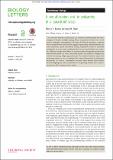A sex allocation cost to polyandry in a parasitoid wasp
Date
03/06/2015Metadata
Show full item recordAbstract
The costs and benefits of polyandry are central to understanding the near-ubiquity of female multiple mating. Here, we present evidence of a novel cost of polyandry: disrupted sex allocation. In Nasonia vitripennis, a species that is monandrous in the wild but engages in polyandry under laboratory culture conditions, sexual harassment during oviposition results in increased production of sons under conditions that favour female-biased sex ratios. In addition, females more likely to re-mate under harassment produce the least female-biased sex ratios, and these females are unable to mitigate this cost by increasing offspring production. Our results therefore argue that polyandry does not serve to mitigate the costs of harassment (convenience polyandry) in Nasonia. Furthermore, because males benefit from female-biased offspring sex ratios, harassment of ovipositing females also creates a novel cost of that harassment for males.
Citation
Boulton , R & Shuker , D M 2015 , ' A sex allocation cost to polyandry in a parasitoid wasp ' , Biology Letters , vol. 11 , 20150205 . https://doi.org/10.1098/rsbl.2015.0205
Publication
Biology Letters
Status
Peer reviewed
ISSN
1744-9561Type
Journal article
Description
R.A.B. is supported by a NERC DTG studentship.Collections
Items in the St Andrews Research Repository are protected by copyright, with all rights reserved, unless otherwise indicated.

